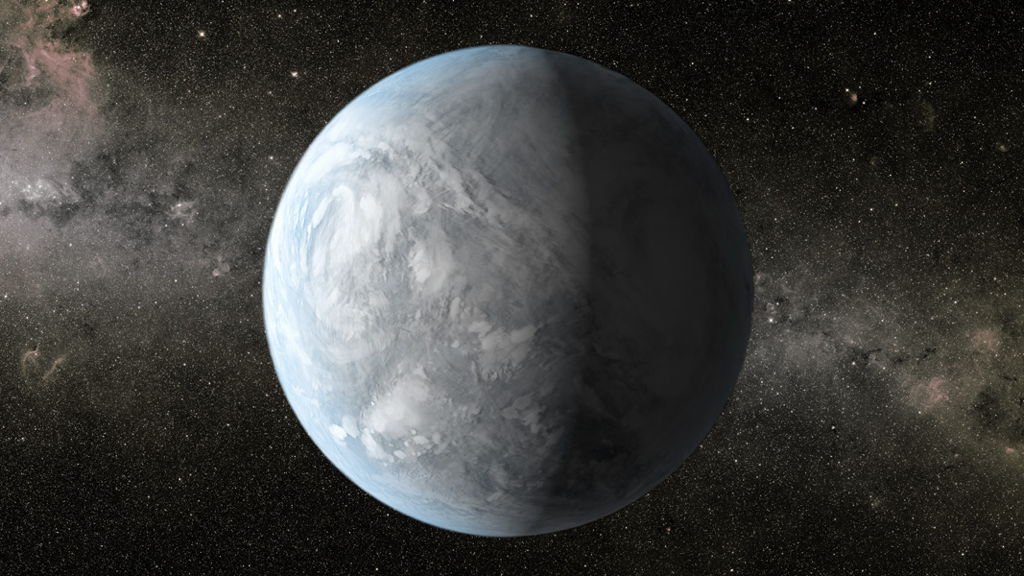
With more and more Earth-like alien planets being discovered around the galaxy, humanity should now start planning out the next steps in its hunt for far-flung alien life, researchers say.
On Thursday (April 18), scientists announced the discovery of three more potentially habitable exoplanets — Kepler-62e, Kepler-62f and Kepler-69c — further suggesting that the cosmos is jam-packed with worlds capable of supporting life as we know it.
So the time is right to get the ball rolling beyond mere discovery to the detailed study and characterization of promising alien planets, researchers said — a task that will require new and more powerful instruments. [Habitable Super-Earths Ideal for Life (Gallery)]
"You really want to collect the light from these planets, to figure out — take the data, not just infer —whether or not there's water, and even signs of life, on these planets," Lisa Kaltenegger of the Max Planck Institute for Astronomy and the Harvard-Smithsonian Center for Astrophysics, who was part of the team that discovered Kepler-62e and f, said during a press conference Thursday.
Billions of Earth-like planets
As their names suggest, the three newfound planets were discovered by NASA's prolific Kepler space telescope, which has spotted more than 2,700 potential alien worlds since its March 2009 launch. Just 122 have been confirmed to date, but mission scientists expect more than 90 percent will end up being the real deal.
The $600 million Kepler mission was designed to determine how common Earth-like planets are around the Milky Way galaxy. Its observations so far suggest our home planet may not be so special.
Sign up for the Live Science daily newsletter now
Get the world’s most fascinating discoveries delivered straight to your inbox.
For example, astronomers recently used Kepler data to estimate that 6 percent of the galaxy's 75 billion or so red dwarfs — stars smaller and dimmer than the sun — likely host habitable, roughly Earth-size planets.
That works out to a minimum of 4.5 billion "alien Earths," the closest of which may be just 13 light-years or so away, according to the study.
While Kepler's work is not done, the instrument has already laid the foundation for the next generation of exoplanet missions, mission team members said.
"In many ways, Kepler was a scout. It scouted deep into the galaxy to find out what the frequencies were, and to show there were a lot of planets to find. It's accomplished that," Kepler science principal investigator Bill Borucki of NASA's Ames Research Center in Moffett Field, Calif., who led the team that found Kepler-62e and f, said at Thursday's press conference.
"And now these new missions will come online and give us more information about these planets," Borucki added, referring to efforts such as NASA's Transiting Exoplanet Survey Satellite, which will launch in 2017 to search for nearby alien worlds. "But the big step is that step where we first start measuring the composition of the atmospheres, and that will be a very technologically difficult task."
Scanning exoplanet air
Borucki and other researchers are keen to get a look at exoplanet atmospheres because the gases present in them can reveal a great deal about the worlds' potential to host life.
Finding carbon dioxide, water and oxygen would bolster the case for a planet's habitability, for example, while spotting extremely complex compounds could make headlines around the world.
"If there are freons, I mean, you've got it made," Borucki said. "Obviously, intelligent life is there."
Studying exoplanets' air will require blocking out the overwhelming glare of their parent stars, which are a billion times brighter than the planets themselves, Borucki said.
That's a daunting task but not an impossible one. A decade ago, in fact, a proposed NASA mission called the Terrestrial Planet Finder (TPF) devised two different techniques to study exoplanet atmospheres, with a possible maximum range of 30 light-years or more.
Funding for TPF never materialized, and the project is now regarded as cancelled. But Borucki expressed confidence that the ongoing exoplanet revolution sparked in large part by Kepler will bring the project back, though not necessarily under the same name.
"Undoubtedly, it at some point will be reinstated," he told SPACE.com. "As we progress in the exploration of the galaxy, looking for life, we must start looking at the atmospheres. Everybody recognizes that."
This story was provided by SPACE.com, a sister site to Live Science. Follow Mike Wall on Twitter @michaeldwall. Follow us @Spacedotcom, Facebook or Google+. Originally published on SPACE.com.











